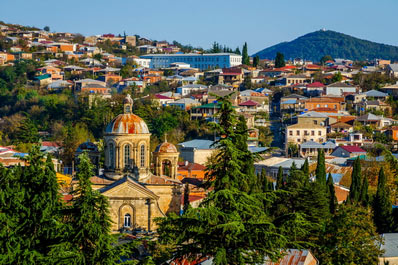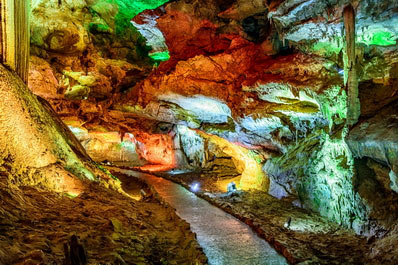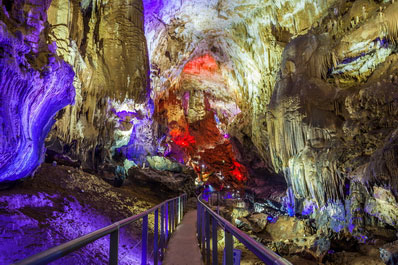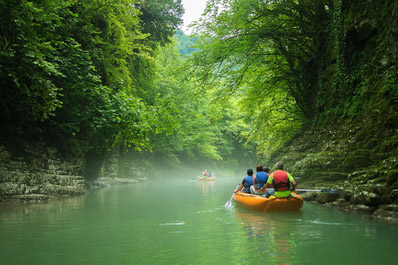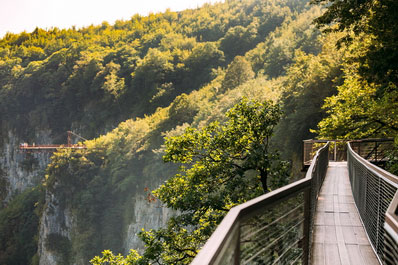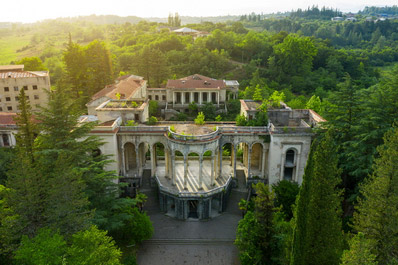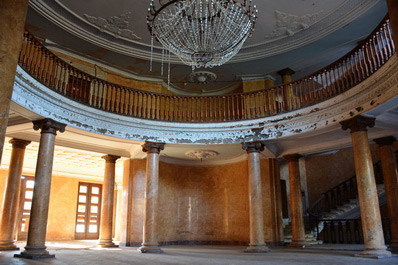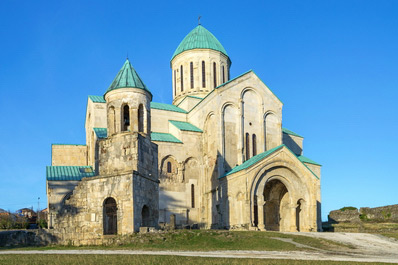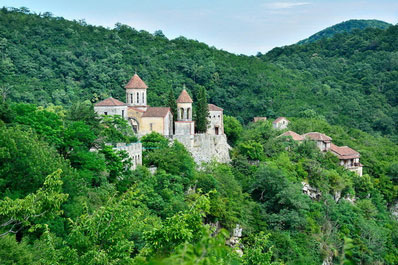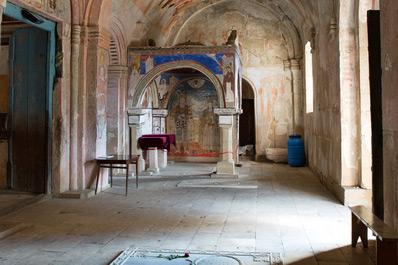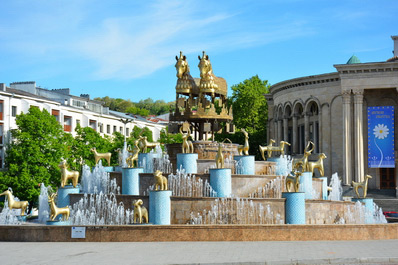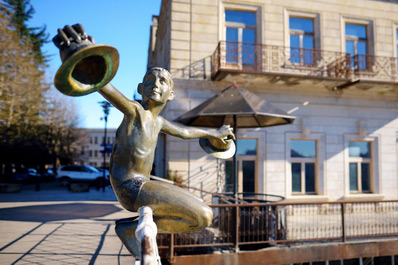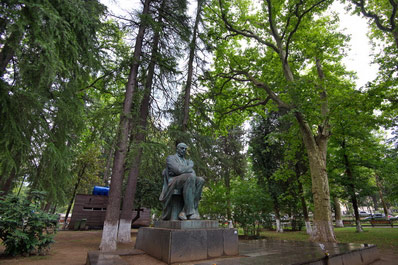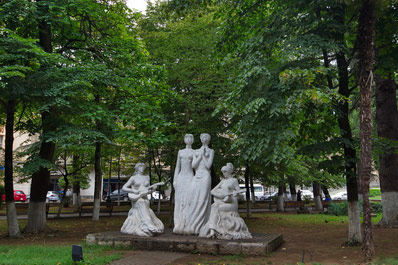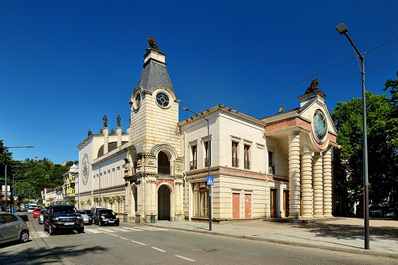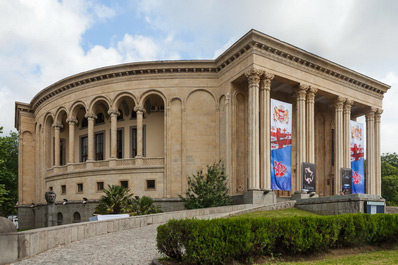Kutaisi, Georgia
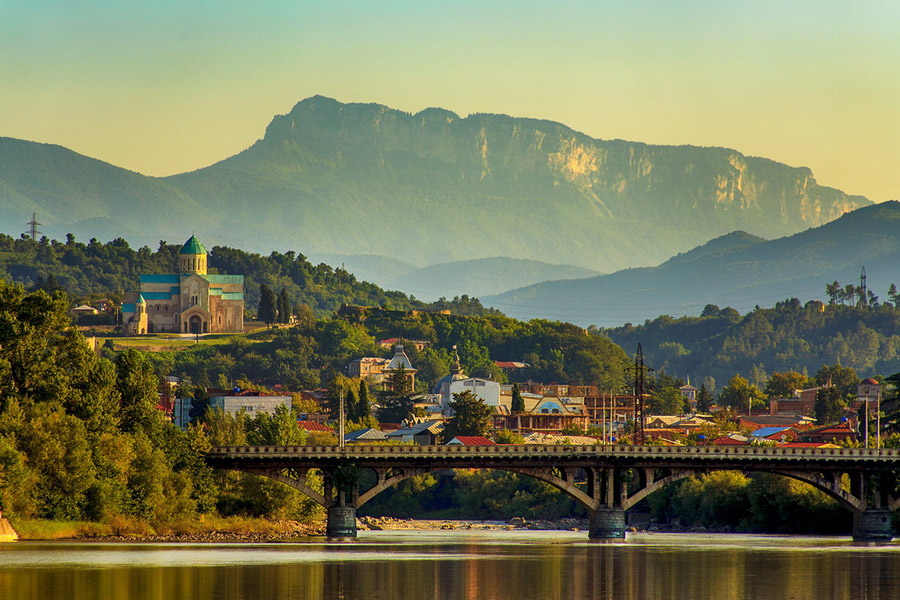
Altitude: 80 to 156 meters above sea level
Official language: Georgian
Popular languages: Russian
Nationality: Georgians, Russians, Armenians, Jews, Ossetians, Kurds.
Time zone: UTC+4
Phone code:+995 431
Postal code: 46ХХ
Vehicle code: GEO
The warm and cozy Georgian city of Kutaisi warmly welcomes travelers from all over the world, showcasing a plethora of attractions. It's home to open-hearted people who are always eager to share the nuances of local culture and daily life, as well as captivating stories from the city's past. In Kutaisi and its surroundings, you can find ancient Georgian temples and monasteries, stunning karst caves, and canyons.
Kutaisi's comfortable climate allows for visits at any time of the year. During the winter months, the temperature rarely drops below zero, making it easy to explore both the city's and nature's attractions. Note that spring and autumn usually see more rainfall.
Kutaisi serves as the administrative center of the Imereti region, and the characteristics of the Imeretian mentality are reflected in the culture and lifestyle of its inhabitants. The people of Imereti are direct descendants of the ancient Colchians, associated with legends and remarkable historical facts.
Today, Kutaisi is open to all who are curious to explore its attractions and artifacts, listen to interesting stories, and immerse themselves in its colorful atmosphere. Where to go and what to do in Kutaisi? Our city guide will tell you about intriguing places and exciting activities.
How to Get to Kutaisi?
Kutaisi is a significant aviation hub in Georgia. A few kilometers from the city is the David the Builder Kutaisi International Airport, which receives flights from major cities in Europe and the CIS countries, as well as from Moscow, Minsk, Abu Dhabi, and other world capitals.
How to get to Kutaisi by land? Buses, minibuses, and trains from Tbilisi, Batumi, Poti, and other major Georgian settlements are available. Train tickets can be purchased online at the Georgian Railways website or at the ticket office of the central station in Tbilisi, located near the Station Square metro station. You can book your bus journey on the City Bus website. Buses leave daily from the "Ortachala" bus station. If you choose the most affordable option and go by minibus, there's no need to buy a ticket in advance. Simply arrive at the "Didube" bus station in the morning, find the departure point for minibuses to Kutaisi, and wait a bit. When the vehicle is full, the minibus will head towards the ancient capital of the Kingdom of Imereti.
Consider that it's much more convenient to entrust the logistics to a professional tour company, which will take care of the transfer and ensure your comfort in a modern vehicle. The company OrexCA will organize for you an interesting and well-thought-out journey through Kutaisi and other cities in Georgia, showcasing the beauty of this vibrant country.
Is Kutaisi Safe?
Kutaisi is a safe city with a hospitable local population. It's believed that the people of Imereti are polite and try to avoid unpleasant situations in communication. They will happily assist if you're unsure how to get somewhere.
However, as in most cities around the world, it's wise to follow basic safety rules to avoid possible difficulties. Do not walk alone on deserted streets at night, use official taxi services, and do not leave your belongings unattended.
A Brief History of Kutaisi
The history of Kutaisi began long before King Vakhtang Gorgasali founded Tbilisi and made it the capital of the Iberian Kingdom. According to scientists, Kutaisi's age could be over 3500 years, although official data state that the city was founded in the middle of the 1st millennium BC.
Kutaisi was one of the first cities of the Kingdom of Colchis, along with Rhodopolis, Nokalakevi, and Vani. Interestingly, Kutaisi was the capital of Colchis.
In the middle of the 6th century AD, Kutaisi experienced the Lazi War – a major conflict between the Byzantines and Persians, with the Colchian capital at the epicenter of fierce battles. Later, Kutaisi became the capital of the Kingdom of Lazica (Egrisi), then part of the Abkhazian Kingdom.
By the end of the 15th century, Kutaisi was the capital of the Kingdom of Imereti, which emerged after the disintegration of the unified Georgian Kingdom. Later, the city was captured by the Turks.
In 1810, Kutaisi became part of the Russian Empire, and in 1918 it was included in the Georgian SSR. After the dissolution of the Soviet Union in 1991, Kutaisi became part of independent Georgia.
Today, Kutaisi is a thriving city that welcomes tourists eagerly, as there's indeed much to see and do.
Kutaisi Sights & Attractions
Kutaisi is renowned for its cozy atmosphere, rich history, and as the setting for the famous Golden Fleece myth. The city, situated along the Rioni River, was historically significant for gold mining using sheepskins. The powerful currents of the Rioni, visible from Kutaisi's White Bridge, evoke images of the legendary Argo ship docking at its banks.
Beyond mythology, Kutaisi is celebrated for its tangible evidence of cultural heritage, boasting historical significance. Visitors are drawn to Kutaisi not only for its ancient lore but also for the numerous attractions in its vicinity. The Prometheus Cave is an expansive space within a rock formation filled with stalactites and stalagmites, where one can wander for hours. Nearby, the Sataplia Reserve is famous for its grotto, where real dinosaur footprints have been discovered.
The breathtaking Martvili and Okatse canyons near Kutaisi are also popular with travelers for their stunning natural beauty. Martvili Canyon allows visitors to boat through verdant gorges, while Okatse Canyon offers spectacular views from a suspension bridge high above the gorge.
About 14 kilometers from Kutaisi's center lies Tskaltubo, known for its Soviet-era architecture and abandoned sanatoriums. Once a premier health resort, many of its facilities now serve as homes to refugees from the early 1990s conflicts. Tskaltubo is a fascinating destination for those interested in Soviet architecture and history, featuring intricate mosaics, wall paintings, and stained glass.
For local flavors and goods, the Kutaisi Green Market is a must-visit. Offering a wide selection of fresh produce, cheeses, spices, nuts, dried fruits, and the iconic churchkhela, the market is a treasure trove for culinary enthusiasts. Sellers often invite customers to sample their goods, with discounts available for bulk purchases.
Kutaisi's Religious Landmarks
Kutaisi and its surroundings are dotted with religious sites of immense historical value. These landmarks have witnessed the epochs of great Georgian kings, writers, and public figures. Among them, the Bagrati Cathedral stands out as Kutaisi's main temple. Built in 1003 during the reign of Bagrat III, it was a contemporary of David IV, known as the Builder. Despite being delisted from UNESCO's World Heritage Sites due to reconstruction controversies, its grandeur remains impressive.
Another significant site is the Motsameta Monastery, dedicated to the martyred brothers Konstantin and David, who were killed for refusing to convert to Islam. Their relics are enshrined within the monastery walls, and their memory is honored annually on October 15th, Motsametoba Day.
The Gelati Monastery is another medieval Georgian architectural gem. Founded in the early 12th century, it served not only as a religious center but also as a cultural hub, housing the famous Gelati Academy. This academy was a beacon of science and culture, where rhetoric, grammar, music, philosophy, astronomy, and mathematics were taught. Today, visitors to Gelati can explore the Nativity of the Virgin Mary Cathedral, the Church of St. George, St. Nicholas' Chapel, and the monastery's extensive library, experiencing a serene atmosphere that invites reflection and peace.
The Peter and Paul Cathedral in Kutaisi is notable for its architecture, featuring a modern-style bell tower. Regular services and pilgrim tours are hosted here, welcoming visitors to its unique structure.
Kutaisi, with its ancient churches and monasteries, verdant canyons, and historical sites, offers a rich tapestry of Georgian culture, history, and natural beauty, making it a compelling destination for any traveler.
Sculptures and Monuments of Kutaisi
Sculptures and monuments in Kutaisi, along with its parks, contribute significantly to the city's cultural landscape, offering both residents and visitors a space for reflection, leisure, and appreciation of the arts.
Arriving in Kutaisi by train, visitors are first greeted by the impressive statue of David the Builder on horseback, located in the square in front of the station. This king, who ruled Georgia for 36 years, is commemorated for his significant contributions to the state's development. The statue, with a sword in one hand symbolizing the bravery and self-sacrifice of Georgians in defense of their homeland and an Orthodox church in the other representing the Georgian people's Christian faith, is a powerful homage to this historical figure.
In the city center, the David Agmashenebeli Square hosts the renowned Colchis Fountain. This tiered fountain is adorned with 30 gilded figures, each an enlarged replica of jewelry and ornaments found during excavations in the Colchis Lowland and Alazani Valley. Among these figures are statues of deer, tigers, rams, mountain goats, and other animals, with the most recognizable being the tamada (toastmaster) with a wine horn and a lion depicted on the old 5 lari banknote.
The White Bridge in central Kutaisi features an unusual sculpture of a boy sitting on the parapet with a hat in each hand, a reference to the 1968 Soviet film "An Unusual Exhibition" by Eldar Shengelaia. This sculpture, known as the "Picasso Boy" evokes a scene where two men, upon seeing a boy, remark on his resemblance to figures Picasso might have drawn, leading to a memorable interaction where the boy takes their hats and dives into the Rioni River.
Near another of Kutaisi's bridges, the Red Bridge, stands a monument to the famous Georgian poet Galaktion Tabidze. This expressive sculpture, depicting the poet with his Muse descending upon him, symbolizes the power of art and its profound impact on humanity.
Kutaisi Parks
Despite its bustling roads and numerous minibusses, Kutaisi offers serene green parks where visitors can relax in the shade of leafy alleys.
The Central City Park, resembling more a spacious square, is filled with tall trees, benches, colonnades, and sculptures, along with a fountain that provides refreshment during the summer heat. A notable sculpture within the park commemorates the Ishkhneli sisters, a musical quartet from the Soviet era famous for their rendition of "Suliko."
For those traveling with children, the Besarion Gabashvili Culture and Recreation Park is filled with attractions ranging from small cars and trains to carousels and a Ferris wheel offering panoramic views of the city. The park also features a sculpture of the Eiffel Tower, providing a unique photo opportunity, and serves as the upper station for the cable car, offering aerial views of Kutaisi's landmarks.
The Kutaisi Botanical Garden, ideal for long walks among greenery, houses over 700 species of trees, shrubs, and other plants from around the world. It features tea bushes, citrus trees, sprawling palms, and fragrant magnolias, along with well-maintained paths, small fountains, gazebos, and neatly arranged flower beds. A unique feature of the garden is a chapel housed within a 400-year-old oak tree.
The Park of Glory, dedicated to the memory of soldiers and civilians who have fallen in conflicts involving Georgia, is another tranquil spot near the Colchis Fountain. It features a fountain, a small memorial with a map of Georgia, and monuments dedicated to World War II.
These spaces not only offer a respite from the urban environment but also serve as cultural and historical touchstones, enriching the experience of those who visit or live in Kutaisi.
Kutaisi Museums
Kutaisi offers a rich array of museums that delve into the history and cultural life of the city, showcasing the deep love Imeretians have for their homeland and providing extensive knowledge about the region's glorious past.
The largest museum in Kutaisi is the State Historical Museum, which houses an extensive collection of priceless artifacts. These include ancient printed materials, coins, jewelry, tools, and items made from metal, clay, and precious stones, many of which belonged to the inhabitants of Colchis and date back to the turn of the 4th and 3rd centuries BCE. The numismatic collection spans various periods of history, and other thematic exhibitions are equally impressive.
Sports enthusiasts can visit the Kutaisi Sports Museum, showcasing the professional achievements of renowned Kutaisi and Imeretian athletes through medals, certificates, trophies, as well as posters of sporting events, photographs of athletes over the years, equipment, and many other items related to various competitions. The rich collection represents the eras of the city's sports culture.
Art lovers should not miss the David Kakabadze Fine Arts Museum, where you can admire the works of famous Georgian painters and sculptors, including several pieces by Niko Pirosmani. This small gallery offers another opportunity to appreciate beauty and see the world through the eyes of talented Georgian artists.
The Museum of Military Glory in Kutaisi presents exhibits related to the heroic deeds of Imereti's inhabitants and military events from different historical periods. Here, you'll find photographs, newspaper clippings, letters, military uniforms, weapons, awards, and other items.
Kutaisi Theatres
Kutaisi's cultural scene is vibrant, with three theatres offering interesting performances weekly.
The Kutaisi State Opera and Ballet Theatre, notable for its unique architecture featuring high columns at the entrance, a "watchtower" with round windows, and statues of ancient heroes on the roof, performs both Georgian classics and world masterpieces like "La Traviata," "Rigoletto," and "The Barber of Seville."
The Lado Meskhishvili Kutaisi Theatre, one of the oldest Georgian theatres with its first performance in the 19th century, features an exquisite interior with a painted ceiling, bas-reliefs, intimate lighting, and a luxurious chandelier. The theatre stages plays by renowned authors like Schiller, Chekhov, Shakespeare, Gogol, Ostrovsky, and many others, offering frequent performances that make it easy to catch a show even without advance planning.
Young audiences will enjoy the vibrant performances at the Gogebashvili State Puppet Theatre. The puppets, meticulously detailed, accurately reflect the characters' personalities, and each story is captivating with intriguing plots and creative twists. A visit to the Kutaisi puppet theatre is sure to delight both children and adults alike, adding a magical touch to the cultural exploration of the city.
Transportation in Kutaisi
Public transportation in Kutaisi is primarily provided by minibuses and city buses that cover all areas of the city and also facilitate travel to nearby suburbs.
Fares for public transport can be paid in cash, with a special transport card, or with any TBC bank card. Transport cards can be purchased at Daily and Family hypermarket branches. In minibuses, payment is cash only. The fare is quite affordable: only 60 tetri. However, travelers often encounter situations where they don't have small change, and it's challenging for minibus drivers to provide change for large bills. Therefore, when moving around the city independently, it's advisable to have small change ready. Fares in Kutaisi must be paid upon entering the vehicle. The fine for fare evasion is 20 lari.
Another challenge with using public transport in Kutaisi is that route directions are only indicated in Georgian. However, locals are always willing to help and provide directions; you just need to ask politely.
Kutaisi is a cozy and welcoming city where you can enjoy exploring cultural and natural attractions. A trip to Georgia wouldn't be complete without visiting this ancient city, which preserves real historical treasures. Be sure to include Kutaisi in your travel plans to enrich your collection of vivid impressions.

